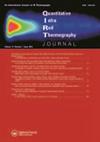深度卷积神经网络在癌症红外成像分类中的应用
IF 4.9
3区 工程技术
Q1 INSTRUMENTS & INSTRUMENTATION
引用次数: 22
摘要
摘要红外热成像是一种可以检测温度模式异常的技术,可以指示包括癌症在内的一些乳腺病变。该方法的一个局限性是缺乏标准化的热成像解释程序。深度学习模型已被用于对象的模式识别和分类,并已被用作医学成像诊断的辅助方法。在本文中,提出使用具有迁移学习的深度卷积神经网络(CNN)将热图自动分类为两类(正常和异常)。311名女性受试者被考虑分析两种方法来测试CNN的表现:一种是均衡的阶级分布,另一种是在典型的筛查队列中进行的研究,异常体温图的发生率较低。结果显示,迁移学习的ResNet-101模型的敏感性为92.3%,特异性为53.8%,而在分布不平衡的情况下,其值分别为84.6%和65.3%。这些结果表明,本工作中提出的模型可以以高灵敏度对异常热图进行分类,这验证了红外热成像作为癌症筛查的辅助方法的使用。本文章由计算机程序翻译,如有差异,请以英文原文为准。
Deep convolutional neural networks for classifying breast cancer using infrared thermography
ABSTRACT Infrared thermography is a technique that can detect anomalies in temperature patterns which can indicate some breast pathologies including breast cancer. One limitation of the method is the absence of standardised thermography interpretation procedures. Deep learning models have been used for pattern recognition and classification of objects and have been adopted as an adjunct methodology in medical imaging diagnosis. In this paper, the use of a deep convolutional neural network (CNN) with transfer learning is proposed to automatically classify thermograms into two classes (normal and abnormal). A population of 311 female subjects was considered analysing two approaches to test the CNN’s performance: one with a balanced class distribution and the second study in a typical screening cohort, with a low prevalence of abnormal thermograms. Results showed that the transfer-learned ResNet-101 model had a sensitivity of 92.3% and a specificity of 53.8%, while with an unbalanced distribution the values were 84.6% and 65.3%, respectively. These results suggest that the model presented in this work can classify abnormal thermograms with high sensitivity which validates the use of infrared thermography as an adjunct method for breast cancer screening.
求助全文
通过发布文献求助,成功后即可免费获取论文全文。
去求助
来源期刊

Quantitative Infrared Thermography Journal
Physics and Astronomy-Instrumentation
CiteScore
6.80
自引率
12.00%
发文量
17
审稿时长
>12 weeks
期刊介绍:
The Quantitative InfraRed Thermography Journal (QIRT) provides a forum for industry and academia to discuss the latest developments of instrumentation, theoretical and experimental practices, data reduction, and image processing related to infrared thermography.
 求助内容:
求助内容: 应助结果提醒方式:
应助结果提醒方式:


